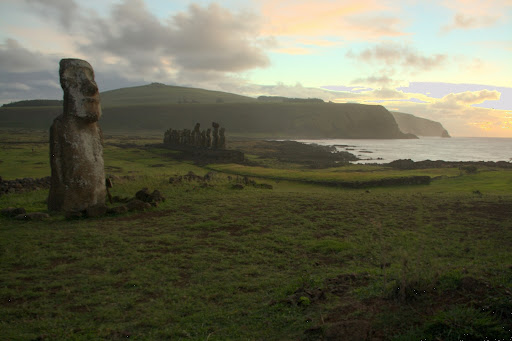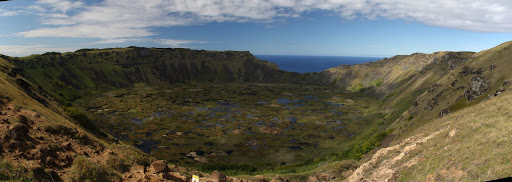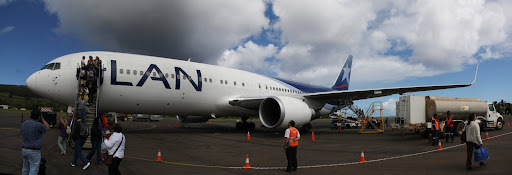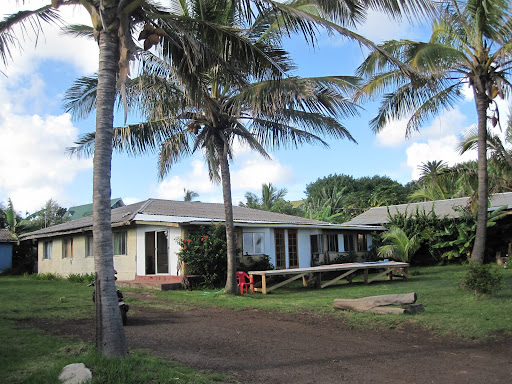
Apina Tupuna Guesthouse
Easter Island has a reputation for being a very expensive travel destination and in some ways this is well-deserved. With round-trip ticket prices from the mainland reaching towards $1000, getting there is certainly expensive. If you can get past the transportation costs (book with miles!) then, with a little effort, the island can be surprisingly affordable. About the same as mainland Chile.
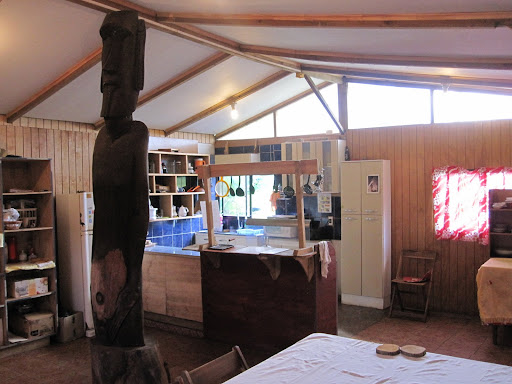
Guesthouse kitchen
Accommodation options on Rapa Nui range from high-end resorts all the way down to camping. Though guesthouse prices are much higher than they were a few years back (when a friend of mine visited) we were still able to find a double room with shared bath at a conveniently located guesthouse for 22,000 CLP per night (about 44 USD). This included breakfast and access to a shared kitchen.
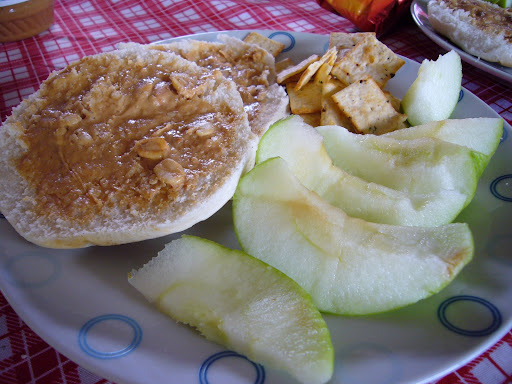
Peanut butter sandwiches, green apples and crackers. Our first meal on Easter Island.
Prepared food is perhaps the biggest budget killer. At the cheap take-away places in Hanga Roa you are looking at $10 or more for a meal and at the proper restaurants upwards of $20 or more. A far more economical option is to prepare your own food. The grocery store prices are certainly higher than the mainland but it is still much cheaper than eating out.
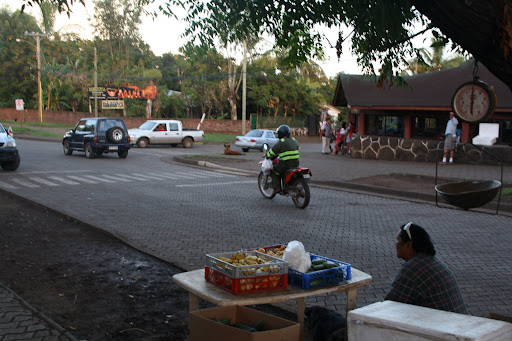
Locals shop for their produce early at the market and the truck vendors
Before we left the mainland we stocked up on some staples (rice, lentils, split peas). During our first afternoon on the island we scoured the minimarkets and found nothing but extremely expensive and bad-looking produce. We learned later that the produce sold in the minimarkets all comes from the mainland on Wednesday’s LAN flight and we were shopping on a Tuesday. Week-old vegetables aren’t that appetizing! A far better option was found the next morning at the town feria were locally-grown produce is sold. Lower prices and higher quality but you have to get there early to get the best veggies.
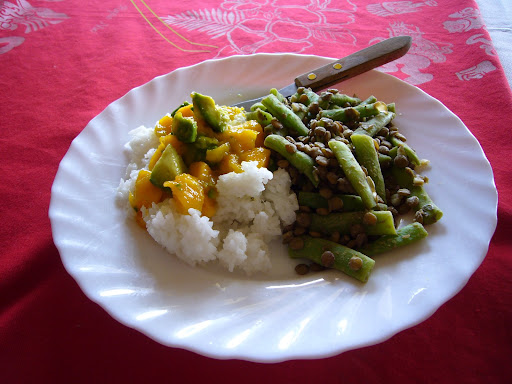
Rice with mango-avocado salsa served with a lentil and green bean salad. Made with local produce.
Using what was at hand, Amy came up with some delicious meals for us to enjoy and I did my best as sous chef and dishwasher. We had everything from pasta salad to mango-avocado salsa served over rice to curried split peas and rice with chard. We cooked once a day and stretched each dish into two meals. Our total spend on food for our six-night stay for two people was under $45!
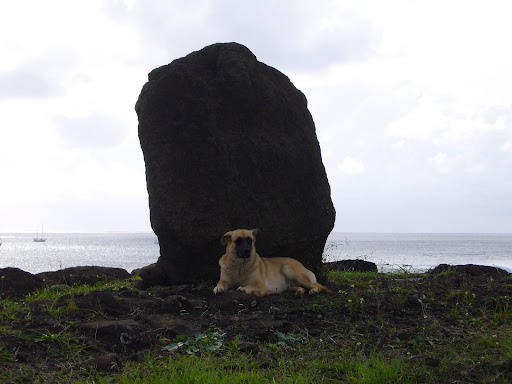
Empanada dog. Always in front of the empada shop next to the harbour. He enjoys the shade of the nearby moai.
The other costs that visitors face on the island are entry fees and transportation. The good news is that most of the ahu scattered around the island are completely free to visit. There is a rather steep entry fee to the island’s two park sites (Orongo and Rano Raraku) but you only pay the 30,000 CLP (60 USD) fee once to enter both sites. On arrival at the airport we were happy to find that the park rangers were pre-selling tickets for 25,000 CLP. If visiting Easter, keep an eye out for the desk just before the baggage claim area.
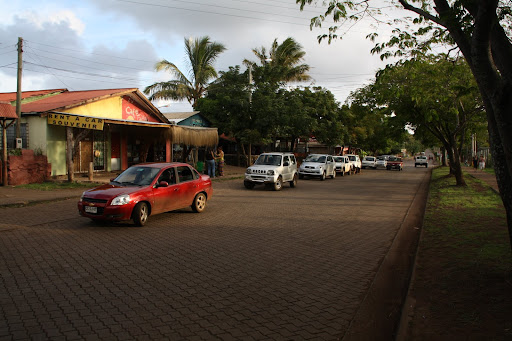
The main drag in Hanga Roa
As for transportation, there are a number of options. Of course you can walk to many of the sights that surround Hanga Roa without much problem. The farther flung sights at the east end of the island are best reached by guided tour or vehicle rental. With two people, renting a car for the day was a much better deal and we could dodge the tour groups. Hitching might also be an option (numerous locals offered us rides) to drive down costs even further.
Easter Island is a destination that can be made affordable with a little effort. Getting to the island can be accomplished with a strategic credit card sign-up bonus or two. Sightseeing on foot and cooking helps the traveler realize even more savings. Of course food shopping, cooking, and walking around take some time so I would highly recommend a 5+ day visit. It is an island paradise, so what’s the rush?
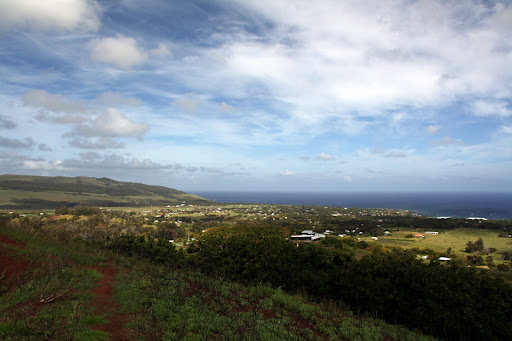
Hanga Roa seen from Puna Pau
Budget Summary:
- Accommodations: $273.68 (six nights)
- Entrance Fees: $105.26
- Food: $44.74
- Car Rental (with fuel): $58.95
- Internet access: $5.05
- Total spent for six days on Easter Island: $487.69 ($40.64 per person, per day)
Another travel blogger has posted his budget for a recent trip to Rapa Nui. Check it out here.
Easter Island – Island Life

Apina Tupuna Guesthouse
|

Our room at Apina Tupuna Guesthouse
|

Guesthouse kitchen
|

Guesthouse common room
|

Front lawn of our guest house. A large visitor offshore that day!
|

Locals shop for their produce early at the market and the truck vendors
|

Breakfast was included
|

Peanut butter sandwiches, green apples and crackers. Our first meal on Easter Island.
|

Tomato and avocado sandwiches ad guava juice.
|

Curried split peas and green beans with rice and wine from the mainland (alcohol is expensive)
|

Rice with mango-avocado salsa served with a lentil and green bean salad. Made with local produce.
|

Pasta salad at the beach along with Amy’s favorite snack: Cabritas (caramel corn)
|

Two important forms of transportation on Rapa Nui
|
|
|

Strange flowers!
|

The daily flight from Santiago
|

The weekly cargo ship from Chile
|
|
|

Occasionally cruise ships visit the island. This is Royal Princess headed for Australia.
|
|
|
|

Empanada dog. Always in front of the empada shop next to the harbour. He enjoys the shade of the nearby moai.
|

Local game of fútbal
|
|

Hanga Roa seen from Puna Pau
|

The bay at Hanga Roa
|

The main drag in Hanga Roa
|
|
|
|
|
|
|
|

Setting of the full moon.
|
|
|






